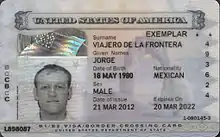Border Crossing Card
A Border Crossing Card (BCC) is an identity document as well as a B1/B2 visa that allows entry into the United States by Mexican citizens. As a standalone document, the BCC allows Mexican citizens to visit the border areas of the U.S. when entering by land or sea directly from Mexico for less than 30 days.[1] The document also functions as a full B1/B2 visa when presented with a valid Mexican passport.[2] Section 104 of the United States Illegal Immigration Reform and Immigrant Responsibility Act of 1996 (IIRIRA) serves as the legal basis for the issuance of Border Crossing Cards.

History of the Border Zone
Since 1953, Mexico and the United States have agreed to make special accommodations for Mexican nationals who cross the U.S.-Mexico border into the immediate border area to promote the economic stability of the region. On November 12, 1953, the United States and Mexico entered into an agreement concerning the U.S.-Mexico border area, which included a provision allowing Mexican nationals who resided near the border to be issued border crossing-identification cards. These cards could be used for multiple applications for admission during the validity of the card. [3]
Eligibility
The BCC is issued only to Mexican citizens residing in Mexico and by the U.S. diplomatic missions in Mexico.[4]
To qualify for the BCC, you’ll need to meet some fundamental requirements including:
- Be a citizen of and resident in Mexico;
- Have a valid Mexican passport at the time of application;
- Meet the eligibility standards for B1/B2 visas; and
- Demonstrate that you have ties to Mexico that would compel you to return after a temporary stay in the United States.
Since the Border Crossing Card is good only on the US border with Mexico, to apply you are most likely to go to one of the six consulates that are near the border.
U.S. Consulate General in Tijuana Paseo de las Culturas s/n Mesa de Otay Delegación Centenario C.P. 22425 Tijuana, Baja California Phone: (664) 977-2000
U.S. Consulate General in Nogales Calle San José s/n Fraccionamiento los Alamos C.P. 84065 Nogales, Sonora Phone: (+52) 631-311-8150 Fax: (+52) 631-313-4652
U.S. Consulate General in Hermosillo 141 Monterey Street Col. Esqueda, C.P. 83000 Hermosillo, Sonora, Mexico Phone: (+52) 662-690-3262 Fax: (+52) 662-217-2571
U.S. Consulate General in Ciudad Juarez Paseo de la Victoria #3650 Fracc. Partido Senecú, C.P. 32543 Ciudad Juárez, Chihuahua, Mexico Phone: 656-227-3000
U.S. Consulate General in Matamoros Calle Constitución No. 1 Colonia Jardín Matamoros, Tamaulipas 87330 Phone: (+52) 868-208-2000 Fax: (+52) 868-816-0883
U.S. Consulate General in Nuevo Laredo Paseo Colon 1901 Colonia Madero Nuevo Laredo, Tamaulipas 88260 Tel: 867 714 0512 (from México), 867-714-0512 (from the US)
Although they will accept applications at the Embassy and Consulates that are not near the border
- U.S. Embassy in Mexico City
- U.S. Consulate General in Guadalajara
- U.S. Consulate General in Merida
- U.S. Consulate General in Monterrey
Description
The first generation of machine-readable BCC's, known as "laser visas",[5] was produced from April 1, 1998, until September 30, 2008. The laminated, credit card-size document is both a BCC and a B1/B2 visitor’s visa. The cards are valid for travel until the expiration date on the front of the card, usually ten years after issuance. They are nearly identical to the previous generation Permanent Resident Card.
October 1, 2008, marked the beginning of production of a second generation B1/B2 visa/BCC. The new card is similar in size to the old BCC, but contains enhanced graphics and technology. The original BCC was produced by the now defunct Immigration and Naturalization Service but the current card is produced by the Department of State.[6] It is virtually identical to the Passport Card, which is issued to citizens and nationals of the United States for the purposes of land and sea border crossings, in its general design layout. The card includes an RFID chip and Integrated Contactless Circuit and is part of the same PASS System that the Passport Card belongs to.[7]
References
- "Frequently Asked Questions". Mx.USEmbassy.gov. n.d. Archived from the original on 7 August 2018. Retrieved 27 March 2019.
- "The Border Crossing Card (BCC) - What documents do I need as a Mexican national to visit the United States?". CBP.gov. 28 May 2020. Retrieved 13 June 2020.
- Federal Register: Notice of proposed rulemaking. (August 9, 2012). "Extension of Border Zone in the State of New Mexico". www.federalregister.gov. Retrieved 28 January 2021.
- "Border Crossing Card". Travel.State.gov. n.d. Retrieved 27 March 2019.
- Branigin, William (18 February 1998). "High-tech ID cards planned for use on Mexican border". The Washington Post. Retrieved 27 March 2019.
- United States Consulate, Monterrey, Mexico (October 1, 2008). "Updated U.S. Border Crossing Card Visa". Archived from the original on July 21, 2011. Retrieved February 8, 2011.CS1 maint: uses authors parameter (link)
- "Forensic Document Laboratory Alert: Counterfeit DSP-150s" (PDF). July 10, 2009. Archived from the original (PDF) on January 28, 2011. Retrieved March 27, 2019.
